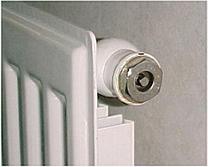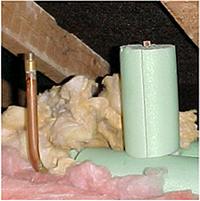Air in a water Central Heating Systems
If bleeding doesn't cure the problem then try this ...
How air enters a water central heating system
When new water is added to a central heating system, a certain amount of air also enters the system.
The action of the impeller of the pump will also 'create' a certain amount of air.
As air will rise in water, it will collect at high points in the system, this is especially noticeable within radiators and in high level circulation pipework.
How to know if there is air in a system.
The most common area of trapped air is in radiators. This is fairly easy to detect as the air will reduce the amount of heat radiated.
With the central heating switched on, feel the top and then the bottom of the radiator - if the top is noticeably cooler than the bottom, there is a good likelihood that there is air in the radiator.
In very severe cases, the whole of the radiator may be filled with air so no difference in temperature will be discernible - if the complete radiator is 'cool' when the central heating is switched on, try bleeding the radiator to ensure that the problem is not just air in the system.
How to bleed a Radiator.
It's a good idea NOT to bleed radiators with the central heating pump ON - if you do, there's always a risk that air might be drawn into the system making your problems worse.
Note that bleeding a sealed system will reduce the pressure which will need to be adjusted afterwards - this is normally done by turning on the mains cold water feed to the system as mentioned in step 6 below. Confirm before starting the bleeding process that you know how to re-pressurise the system - if in doubt, consult a heating engineer.

- With warm water in the radiator, switch off the Central Heating system.
- Fit a bleed key onto the bleed valve (this is usually at the top at one end of the radiator - on some designs of radiator, it may be at the back).
- Loosely wrap a piece of old cloth around the key to catch any expelled water.
- Open the bleed valve by turning the bleed a 1/2 turn anti clockwise - hissing of air being expelled will normally be heard.
- When water starts to dribble out of the valve, close the valve by turning the key a 1/2 turn clockwise. DO NOT OVER TIGHTEN.
- If the Central Heating system is a sealed system, check the pressure and, if necessary, top up the pressure as required (often 1 bar but check the instructions).
How to bleed the circulation system.

- With warm water in the radiator, switch off the Central Heating system.
- The bleed valve often has a knurled release so no special key is required..
- Loosely wrap a piece of old cloth around the valve to catch any expelled water.
- Open the bleed valve - hissing of air being expelled will normally be heard.
- When water starts to dribble out of the valve, close the valve by turning it clockwise. DO NOT OVER TIGHTEN.
- If the Central Heating system is a sealed system, check the pressure and, if necessary, top up to the pressure as required (often 1 bar but check the instructions).
And if that doesn't cure the problem .............
Sometimes bleeding a radiator does not cure the problem of it not getting hot, if this happens and the radiator has never worked since it was installed or last removed/refitted then:
- Check that the shield valve is not closed down too far - have a look at this page.
- Check that if a thermostat valve is fitted, it is on the inlet to the radiator not the outlet - these types of valve often need the flow of circulating water to lift the valve off its seat.
If the radiator is not getting hot but it has worked fine at sometime since any work was carried out:
- An air lock may have developed in the pipe work.
- The inlet or outlet of the radiator may have become blocked, Try opening up both the control and shield valves (count the number of turns on the shield valve so you can reset it).
If all else fails, the radiator will need to be removed and the individual components checked for any blockage.
